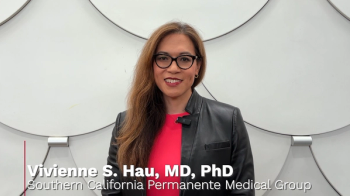
Shedding light on racial inequities in ophthalmology and ocular healthcare
AAO develops task forces to evaluate academy, review outcomes in ophthalmology.
Reviewed by Tamara Fountain, MD.
The racial gap in health outcomes is well recognized and has been for a while. Shockingly, the gap between the death rates of Black and Caucasian Americans is so great that if all the deaths from the COVID-19 virus among Black Americans in 2020 were eliminated, it is estimated that the difference in the death rates would still be higher for African Americans, according to Tamara Fountain, MD, president of the American Academy of Ophthalmology (AAO).
According to Fountain, the racial disparities in societal institutions over and above health care, such as housing, education, criminal justice, and economics, are due partly to inequities that have existed for decades or centuries in the US. The result of these disparities has been the disenfranchisement of people of minority racial backgrounds.
“Implicit bias plays a big role and this is where changes can be made in health care for the better,” she said.
Fountain described how the New York Philharmonic orchestra overcame its gender bias with a wildly simple approach. She explained that in 1960, the philharmonic was made up solely of white men; by the 1970s, the value of diversity was beginning to be recognized and the women’s movement began.
But despite societal changes, men continued to be selected during auditions. The blind audition was introduced, i.e., a curtain divided the judges and the auditioning musicians. The number of women chosen skyrocketed to a 500% increase in their numbers in the orchestra.
Bias rears its ugly head in some surprisingly unexpected places, Fountain said. Pulse oximeters, for example, which are readily available commercially, may provide biased results for darker-skinned individuals. The algorithm in some oximeters is skewed when the device is put on a brown or black finger and the calibration was set to a default value for a white finger and found to be inaccurate, Fountain said. “This can have a direct effect on medical outcomes, and it is surprising how a relatively insignificant bias can creep into health care,” she said.
Moreover, Fountain also pointed out how prejudging individuals by appearance, manner of speaking, or skin color can result in erroneous snap judgments about individuals. People have implicit biases, she noted, adding that she has some of her own.
One time, she mistook a Black surgeon in her hospital for a transport technician because up to that moment she had been the only Black surgeon in her hospital, which employed 5 Black transport technicians. While most of these so-called blind spots are innocent, they can interfere with the best physician-patient relationship.
Heath disparities in eye care
Fountain cited a study that found that when Black men are treated by a Black doctor, they receive more effective care,1 showing that common cultural background and language lead to better health outcomes.
One problem in medicine is that minority ethnic groups—African Americans, Hispanics, and Native Americans—are traditionally underrepresented. Minorities constitute 31% of the US population but only 6% of practicing ophthalmologists.2
“This represents a pipeline problem in trying to get a representative slice of America as health care providers,” Fountain said.
Former presidential candidate and New York City mayor Michael Bloomberg took a step to alleviate this problem, committed in 2020 to donating $100 million to historically Black US medical schools to increase the graduation rate. This donation, as reported in The New York Times, was “meant to ease students’ debt and free them to serve in needy communities.”
Underrepresented minorities
About 5 years ago, the AAO recognized the pipeline problem and set out to cultivate the next generation of ophthalmologists through its Minority Ophthalmology Mentoring (MOM) program.
According to Fountain, MOM targeted medical students in their first 2 years of medical school and encouraged them to consider careers in ophthalmology.
“The students were invited to the annual meeting, paired with mentors, and shown wet labs and the exhibit floor,” she said. “During the following year, the students and mentors remained in close contact to answer any questions about a career in the specialty.”
As a result of the 2-year MOM pilot, the Association of University Professors of Ophthalmology along with the AAO donated $1 million to the program in 2016-2017. Only through continued support from the broader house of ophthalmology, including subspecialty and special-interest societies as well as an infusion of corporate support during the social justice movement, did the field of students increase to 50 in the 2020 class, she explained.
“It will take time to see the fruits of this effort, but we are putting our faith in this program and it is enjoying increasing support from corporate partners and other sponsors,” she said.
Another problem is that once students choose ophthalmology as a specialty, entry into a program is difficult. Ophthalmology is among the bottom 5 specialties into which the underrepresented minorities are accepted for residency.
AAO efforts
The AAO has developed 2 task forces. The first is evaluating the AAO itself to determine if the academy is living up to its mission to have equal representation in leadership, committee chair structure, awards, and the speakers chosen for the annual meeting.
The second task force is looking at clinical outcomes in ophthalmology and the racial disparities within. To accomplish this, the AAO is using the data in the IRIS Registry and partnering with industry to mine their data. In addition to leveraging data, the task force will focus on access, workforce issues, and educational resources, with the goal of narrowing the racial gaps in ocular health outcomes.
Fountain summarized by noting that health care professionals have an individual and collective responsibility to understand the historic roots of contemporary health disparities3 in order to mind the racial gap.
References
1. Alsan M, Garrick O, Graziani GC. Does diversity matter for health? Experimental evidence from Oakland. National Bureau of Economic Research. Revised August 2019. Accessed May 14, 2021. https://www.nber.org/papers/ w24787
2. Xierali IM, Nivet MA, Wilson MR. Current and future status of diversity in ophthalmologist workforce. JAMA Ophthalmol. 2016;134(9):1016-1023. doi:10.1001/ jamaophthalmol.2016.2257
3. Hardeman RR, Medina EM, Kozhimannil KB. Structural racism and supporting black lives—the role of health professionals. N Engl J Med. 2016;375(22):2113-2115. doi:10.1056/NEJMp1609535
TAMARA FOUNTAIN, MD
e: tfountainmd@gmail.com
This article is adapted from Fountain’s presentation at the Ohio Ophthalmological Society’s 2021 virtual annual meeting. She has no financial interest in this subject matter.
Related Content:
Newsletter
Keep your retina practice on the forefront—subscribe for expert analysis and emerging trends in retinal disease management.









































